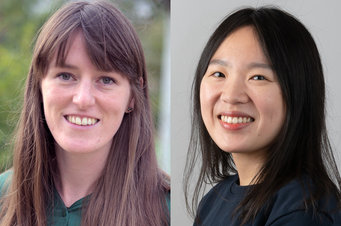Claire Donnelly and Eugene Kim will receive the 2024 Heinz Maier-Leibnitz Prize of the German Research Foundation
This year, alongside two other female and six male scientists, Claire Donnelly and Eugene Kim will receive Germany’s most prestigious award for researchers in the early stages of their careers. Each recipient will receive a prize of 200,000 euros, intended to support further research endeavours for a period of up to three years. The awards ceremony is scheduled to take place on June 4, 2024 in Berlin.

Successful basic research: Claire Donnelly and Eugene Kim receive the 2024 Heinz Maier-Leibnitz Prize of the German Research Foundation
© MPG
Claire Donnelly, who conducts research at the Max Planck Institute for Chemical Physics of Solids and TU Dresden, investigates the unique physical properties of nanomaterials. Materials with very small dimensions of one to 100 nanometres – a nanometre is one millionth of a millimetre – have fascinated technology and science for years. This is because within microscopically small solid-state structures, nanometre-scale areas can be distinguished that have completely different magnetic properties.
Donnelly’s research is dedicated to the targeted production of nanomaterials with specific magnetic properties. Thanks to her work, researchers are already able to investigate and spatially visualise the magnetic properties of tiny three-dimensional solid-state systems – with a temporal resolution in the picosecond range, i.e. a trillionth of a second.
3D genome organisation
Cells possess remarkable abilities to cram vast amounts of genetic information into the smallest of spaces. Chromosomes as carriers of genetic material are compressed by nearly three orders of magnitude so that they fit into the cells. But how do chromosomes manage to adopt their three-dimensional structure within the cell nucleus? Eugene Kim is dedicated to unraveling this mystery at the Max Planck Institute of Biophysics in Frankfurt am Main. Through her research, she seeks to elucidate the organisational principles governing the genome’s three-dimensional arrangement within the nucleus of cells.
She uses and develops single-molecule biophysics imaging techniques to uncover the molecular processes underlying the chromosome packing process. Thanks to her research, cell biologists gain deeper insights into the organisation and packaging of chromosomes with the help of the protein complex condensin. Kim’s contributions, for example, have unveiled how several such condensins work together to form the structure of chromosomes without colliding and interfering with each other. Her methodological developments are incorporated into her own research programme on the 3D organisation of the genome.
DFG/BA








